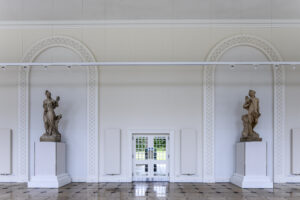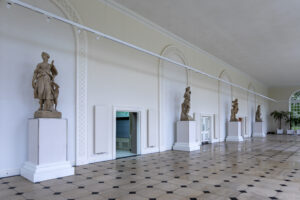27 Jul “The Royal Botanic Gardens” Kew, London

As a mural artist based in London I have been commissioned to do a range of murals both in London and abroad, sometimes in well known locations. For example one of the more unusual mural locations was the Lion area in ZSL ( London Zoo). More recently I was asked to tender for a trompe l’oeil mural commission in the Orangery in Kew Gardens.
The Orangery at Kew Gardens was the very first of the buildings to be designed and built for the gardens in the classical style and it was also the largest, measuring 10 x 28 metres.
It was commissioned by Princess Augusta and built in 1761 by Sir William Chambers who was also tutor to her son the future King George 111.
It was originally designed to grow lemons and oranges but because it was so big and did not have enough glazing compared to brick work it did not effectively function for this purpose. In 1841 the resident citrus trees were temporarily moved to the Orangery at Kensington Palace whilst the building was renovated by Sir William Hooker. He improved the light sources by including giant glazed doors at either end allowing more natural light to flow
in. This improvement allowed the building to be used for the large plants too big for the other glasshouses.
The orangery has been used for various purposes in the 1860’s it acted as a museum for British timber, showcasing thousands of samples of wood taken from all over the British Empire. In 1989 the Orangery listed as a grade 1 listed building became a tea room and then the Orangery restaurant serving meals to the millions of visitors Kew receives each year. It was evident that due to the very large size of the building that it had a problem with the acoustics and that any sound was amplified, this was such a challenge to solve that students at Royal Architectural College did a
thesis on how to solve it.
More recently as well as a restaurant the Orangery can be hired in the evenings for events but something had to be done regarding the sound level. I was contacted by a firm of architects, Acanthus Clews, late last year who had been awarded the 4 million contract for the refurbish of the Orangery and other areas in Kew Gardens.

The lead conservation architect for Acanthus Clews, was looking for a trompe l’oeil mural artist and I had been recommended for the project along with one other mural artist. It had been decided to refurbish the
Orangery incorporating the latest sound absorbing technology.
A part of the new design for the Orangery was replicating the huge windows with 4 arches 6 metres high to surround 4 large statues on loan to Kew from the British Museum.
It was one of those mural commissions that I said yes automatically and then tried to work out the budget and how to do it within the timescale. It was 60 metres of trompe l’oeil at a height of 6 metres to be completed in a few weeks.
Using a company that are experts in stencil cutting they made me a template to execute the work with precision and speed, that also affected the cost which allowed me to be competitive.
Using a combination of scaffolding, towers and ladders and two young mural artist assistants working in conditions not empathetic to creating trompe l’oeil on a large scale we completed the commission in exactly two weeks.




No Comments